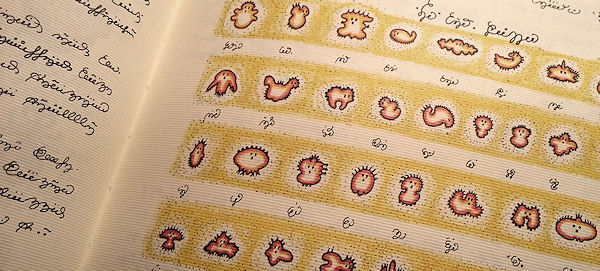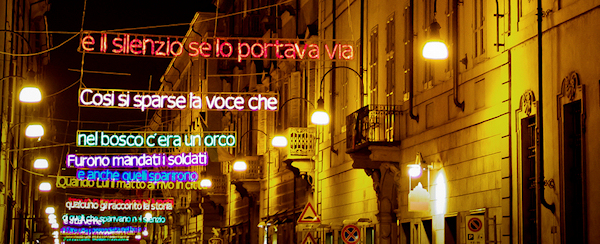MARIANO TOMATISWONDER INJECTORItalian writer and magician
|
 Magic & TimePast, Present and Future in three magic experiences Posted on tuesday 5 august 2014, 3 days before scifoo14 • Written by Mariano TomatisBeing a magician does not require a stage, a strange hat or a bag full of tricks. Daily life offers lots of opportunities to create unusual (or even impossible) situations, breaking into reality with apparently magical events. To define such a fascinating task, Ferdinando Buscema coined the expression Magic Experience Design. In order to make you appreciate its potential, here are three striking examples, involving the concept of Time and offering food for thought about Past, Present and Future. The Past: What is the feeling of being children? Since a few months, the reprint of the Codex Seraphinianus is available in bookstores: it is one of the most fascinating and mysterious books ever conceived. Created by Luigi Serafini between 1976 and 1978, it has the appearance of a bizarre 360-pages encyclopedia. Its handwriting, however, is incomprehensible: Serafini used an elegant script language which does not reproduce any existing or imaginary idiom.  Images of surrealist taste offer the reader some vague clue about the content of the book, without solving any mystery — and indeed, making it more dense. The Codex offers a magic experience, fulfilling the wish of reviving a typical feeling of childhood. As Serafini wrote: I want the reader flipping through the “Codex Seraphinianus” to be like […] a child who has not yet learned to read, but rejoices in dreams or the fantasies the images suggest. (1) The most recent edition includes another paragraph on this: Do you remember how, when we were children, we’d leaf through picture books and, pretending we could read before the children older than us, fantasize about the images we saw there? Who knows, I thought to myself, perhaps unintelligible and alien writing could make us all free to once again experience those hazy childhood sensations. (2) The Present: the right pace to savor it During the Christmas season, the city of Turin turns on the Luci d’Artista (Artists’ Lights) — light installations decorating the main streets and squares. Luigi Mainolfi’s work extends along via Lagrange and tells — through a number of neon lights — a story written with Guido Quarzo: “Luì and the art of strolling into the woods.” (3)  If you read the story on a page (by clicking here), you will live a kind of experience. If you walk through via Lagrange from the beginning to the end, it will take about 15 minutes to read the same words. In the meantime, your look will cross the passers-by, will fall on a shop window and you will be distracted by the elegant architecture of a building. The act of reading will be fragmented: although the words are exactly the same, the eye will not be able to catch all of them at a single glance. The pace will be dictated by the speed of your steps, and the mental effort to connect each sentence to the previous one will be hindered by a thousand surrounding stimuli. The story told by Guido Quarzo is — even on paper — a surreal sequence of images, sounds and situations. And if it is already difficult to hold it together during a conventional reading, the fragmentation added by Mainolfi is an extra element of disorientation, offering those who go along the Turinese road a suggestive magic experience: rationality lacks any explanatory power, and the reader is forced to be lulled by the slow rhythms and hypnotic tunes orchestrated by whales, ogres, elephants and rattles. “Luì and the art of strolling into the woods” invites you to dive into the Present with the slow pace imposed by a full awareness, rewarding an open attitude towards the surreal and frustrating any attempt to deconstruct the mechanism by rational means. But it is just a humble invitation: those in a hurry can spare themselves all the magic, clicking on the link above and devouring the story in a few seconds. The Future: What is the feeling of being old?  It is not easy, for those who are young, to empathize with the elderly and guessing the effects of the physical limitations produced by aging. In order to enable students of geriatrics to immerge themselves for a few hours in the feeling of being elderly, Wolfgang Moll has created a magical aging suit (on sale here): it is called GERT and it is a dress whose structure simulates a series of obstacles related to the Third Age. Opaque lenses simulate problems with vision, noise-canceling headset impose hearing restrictions, stiff joints reproduce the obstacles in the mobility of the head, joints and gripping ability. The weight of the suit simulates the loss of strength and coordination skills. Some expansions of the suit enable other limitations typical of aging: the “trembling simulator” simulates the senile tremor, the “overshoes” force to maintain unsteady gait, the “hemiparesis simulator” simulates a one-sided paralysis. The magic experience of living in advance old age has extraordinary effects on young people, encouraging empathy towards the elderly. Research conducted at the University of Würzburg (published here) showed that the ability to empathize with 125 students rose to 90% after wearing the suit for an hour and a half. _________________ (1) Frontpiece of the first edition of Luigi Serafini, Codex Seraphinianus, Franco Maria Ricci, 1981. (2) Luigi Serafini, Decodex, Rizzoli, Milan 2013, p. 9. (3) Guido Quarzo and Luigi Mainolfi, Luì e l’arte di andare nel bosco, Hopefulmonster, Florence 2002. You could be interested also in: |
 Science Foo Camp (or “Sci Foo”) is an invitation-only gathering organized by Digital Science, O'Reilly Media, and Google, with support from Nature. The 9th edition of Sci Foo takes place on 8-10 August 2014 at the Googleplex in Mountain View, CA. Lord Martin Rees has defined it as “a sort of mini Woodstock of the Mind”. Participants include researchers, writers, educators, artists, policy makers, investors, and other thought leaders, all doing groundbreaking work in diverse areas of science and technology.
Science Foo Camp (or “Sci Foo”) is an invitation-only gathering organized by Digital Science, O'Reilly Media, and Google, with support from Nature. The 9th edition of Sci Foo takes place on 8-10 August 2014 at the Googleplex in Mountain View, CA. Lord Martin Rees has defined it as “a sort of mini Woodstock of the Mind”. Participants include researchers, writers, educators, artists, policy makers, investors, and other thought leaders, all doing groundbreaking work in diverse areas of science and technology.